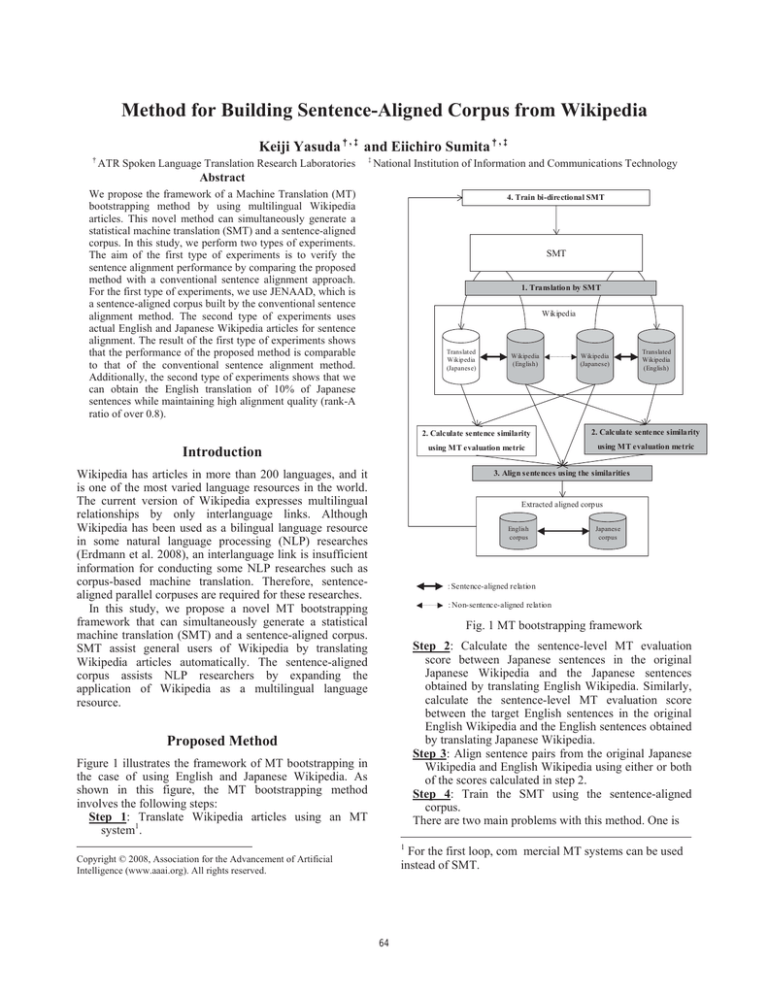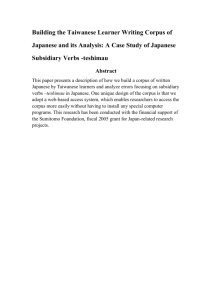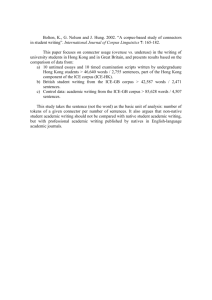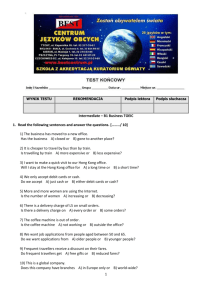
Method for Building Sentence-Aligned Corpus from Wikipedia
Keiji Yasuda†,‡ and Eiichiro Sumita†,‡
†
ATR Spoken Language Translation Research Laboratories
‡
National Institution of Information and Communications Technology
Abstract
We propose the framework of a Machine Translation (MT)
bootstrapping method by using multilingual Wikipedia
articles. This novel method can simultaneously generate a
statistical machine translation (SMT) and a sentence-aligned
corpus. In this study, we perform two types of experiments.
The aim of the first type of experiments is to verify the
sentence alignment performance by comparing the proposed
method with a conventional sentence alignment approach.
For the first type of experiments, we use JENAAD, which is
a sentence-aligned corpus built by the conventional sentence
alignment method. The second type of experiments uses
actual English and Japanese Wikipedia articles for sentence
alignment. The result of the first type of experiments shows
that the performance of the proposed method is comparable
to that of the conventional sentence alignment method.
Additionally, the second type of experiments shows that we
can obtain the English translation of 10% of Japanese
sentences while maintaining high alignment quality (rank-A
ratio of over 0.8).
4. Train bi-directional SMT
SMT
1. Translation by SMT
Wikipedia
Translated
Wikipedia
(Japanese)
Introduction
Wikipedia has articles in more than 200 languages, and it
is one of the most varied language resources in the world.
The current version of Wikipedia expresses multilingual
relationships by only interlanguage links. Although
Wikipedia has been used as a bilingual language resource
in some natural language processing (NLP) researches
(Erdmann et al. 2008), an interlanguage link is insufficient
information for conducting some NLP researches such as
corpus-based machine translation. Therefore, sentencealigned parallel corpuses are required for these researches.
In this study, we propose a novel MT bootstrapping
framework that can simultaneously generate a statistical
machine translation (SMT) and a sentence-aligned corpus.
SMT assist general users of Wikipedia by translating
Wikipedia articles automatically. The sentence-aligned
corpus assists NLP researchers by expanding the
application of Wikipedia as a multilingual language
resource.
Wikipedia
(English)
Wikipedia
(Japanese)
Translated
Wikipedia
(English)
2. Calculate sentence similarity
2. Calculate sentence similarity
using MT evaluation metric
using MT evaluation metric
3. Align sentences using the similarities
Extracted aligned corpus
English
corpus
Japanese
corpus
: Sentence-aligned relation
: Non-sentence-aligned relation
Fig. 1 MT bootstrapping framework
Step 2: Calculate the sentence-level MT evaluation
score between Japanese sentences in the original
Japanese Wikipedia and the Japanese sentences
obtained by translating English Wikipedia. Similarly,
calculate the sentence-level MT evaluation score
between the target English sentences in the original
English Wikipedia and the English sentences obtained
by translating Japanese Wikipedia.
Step 3: Align sentence pairs from the original Japanese
Wikipedia and English Wikipedia using either or both
of the scores calculated in step 2.
Step 4: Train the SMT using the sentence-aligned
corpus.
There are two main problems with this method. One is
Proposed Method
Figure 1 illustrates the framework of MT bootstrapping in
the case of using English and Japanese Wikipedia. As
shown in this figure, the MT bootstrapping method
involves the following steps:
Step 1: Translate Wikipedia articles using an MT
system1.
1
For the first loop, com mercial MT systems can be used
instead of SMT.
Copyright © 2008, Association for the Advancement of Artificial
Intelligence (www.aaai.org). All rights reserved.
64
the computational cost of implementing the above steps.
Step 3 in particular requires excessive calculations because
we have to calculate a sentence-level score for 2 × nsource ×
ntarget pairs, where nsource is the number of sentences in the
source language comparable corpus and ntarget is the
number of sentences in the target language comparable
corpus.
One method to reduce the calculation cost is to use an
interlanguage link to prune candidate articles. Then, a
sentence-level bilingual evaluation understudy (BLEU)
score can be calculated only for the candidate articles. This
method effectively reduces the computational cost of step 3.
However, the iteration of steps 1 to 4 still induces a large
computational cost. To deal with these problems, we have
raised funds and we use a supercomputer (HPC2500, 2002).
The other problem concerns the alignment confidence
measure that is based on the MT evaluation measure. Most
proposed MT evaluation measures are used to evaluate
translation quality, and no research uses these measures for
evaluating sentence alignment confidence. If our proposed
framework functions effectively, it will be a promising
application because most MT evaluation techniques do not
require any language resources such as a bilingual
thesaurus or lexicon, which are used in most conventional
sentence alignment methods. In the experiments described
in the next section, we test the effectiveness of the MT
evaluation technique.
Initial parallel corpus
1. Train
Source
language
Target
language
3. Calculate sentence similarity
using MT evaluation metric
2. Translation by SMT
4.Filter out sentence pairs
using the MT evaluation metric
bi-directional SMT
SMT
Translated corpus
5.Retrain SMT
Translated
corpus
(source
language)
Translated
corpus
( target
language)
Fig. 2 Flow of JENAAD corpus experiments
To evaluate the effectiveness of the MT evaluation
measure in sentence alignment, we compare the system
performance before and after filtering. If the measure is
useful for sentence alignment, we can reduce the size of
the training set for the SMT without degrading the
performance, by filtering out unreliable sentence pairs.
We used the JENAAD corpus, which is a JapaneseEnglish newspaper corpus aligned by a conventional
sentence alignment method (Utiyama & Isahara 2003). We
use 150,000 sentence pairs from the corpus. For the SMT
training, we use a Pharaoh training toolkit and an SRI
language model toolkit.
Experimental results. Table 1 lists the results of the
JENAAD corpus experiments. The BLEU score of the
500-sentence-pair test set is calculated in a manner similar
to that in previous experiments. Here, the baseline system
is trained on the sentence pairs that are filtered using the
measure proposed by Utiyama et al. (Utiyama & Isahara
2003). As indicated in the table, the performance of the
proposed method is comparable to that of the conventional
sentence alignment measure.
Experiments
We perform two types of experiments. The aim of the
first type of experiments is to verify the sentence alignment
performance by comparing the proposed method with a
conventional sentence alignment approach. A JENAAD
corpus, which is a sentence-aligned corpus built by the
conventional sentence alignment method, is used for the
experiments. The second type of experiments uses actual
English Wikipedia and Japanese Wikipedia articles for
sentence alignment.
Experiments using Wikipedia
Experiments using JENAAD corpus
Experimental settings.
In the experiments using
Wikipedia, we execute the first loop of the components
shaded in gray2, shown in Fig. 1, in order to verify the
relationship between the yield ratio and the alignment
quality.
The other experimental conditions are as
follows:
-The Wikipedia version is Sept. 2007.
-The number of sentences from Japanese Wikipedia is
1,500.
-The sentences of Japanese Wikipedia are preprocessed
by a Chasen morphological analyzer.
-The number of sentences from English Wikipedia is
50,000,000.
Experimental settings. To verify the effectiveness of
sentence alignment based on the MT evaluation measure,
we perform the experiments depicted in Fig. 2 by using a
preliminary sentence-aligned corpus. As shown in this
figure, the experiments involve the following steps.
1. Train the SMT using the preliminary sentence-aligned
corpus.
2. Translate the corpus using the trained translation
system.
3. Calculate the sentence-level BLEU score (Papineni et
al. 2002) between the preliminarily aligned sentence
pairs.
4. Filter out unreliable aligned pairs using the BLEU
score.
5. Retrain the STM using the filtered sentence pairs.
2
In these experiments, we used a commercial MT system
instead of SMT.
65
Table 1 Results of JENAAD corpus
automatically updates the lexicon using the aligned
sentences by the method by Fung and Cheung and that by
Munteanu and Marcu These methods (Fung & Cheung
2004; Munteanu & Marcu 2006) use some elemental
technology of STM to build a bilingual lexicon
automatically; however, the entire STM technology has not
been used. This is one of the differences between the
proposed method and the conventional method.
# of the training
BLEU score
sentence pairs
Proposed method
50000
0.1019
Proposed method
100000
0.109
Baseline
50000
0.1069
Baseline
100000
0.1057
Baseline
150000
0.1092
Method
1
Rank-A ratio
Yield ratio
Ratio
0.8
Conclusions
0.6
We have proposed an MT bootstrapping method that
simultaneously generates an STM and a sentence-aligned
parallel corpus. This method iterates the following steps:
(1) translation of a comparable corpus using the SMT, (2)
sentence alignment of the comparable corpus using the MT
evaluation measure, and (3) SMT training.
To test the effectiveness of the proposed method, first,
we conducted preliminary experiments using a newspaper
corpus. According to the experimental results, we thought
that the sentence alignment based on the MT evaluation
measure was effective and performed comparably to the
conventional sentence alignment method.
Second, we performed sentence alignment experiments
using English and Japanese Wikipedia articles.
The results of these experiments show that we can obtain
the English translation of 10% of Japanese sentences while
maintaining high alignment quality (rank-A ratio of over
0.8).
0.4
0.2
0
0.7
0.8
0.9
1
Threshold (PER)
Fig. 3 Results of Wikipedia experiments
To align the Japanese and English sentences (step 3 in
Fig. 1), first, we calculate the sentence similarity between
Japanese sentences and all 50,000,000 Japanese translated
sentences. We consider that original English sentence of a
Japanese translated sentence, which gives the highest
similarity value. For English sentences extracted from
English Wikipedia articles as the translations of 1,500
Japanese sentences, we carry out a two-grade subjective
evaluation using the following definition.
Rank A: more than 60% overlap.
Rank B: less than 60% overlap.
Experimental results. Figure 3 plots the results obtained
by the Wikipedia experiments. In this figure, the vertical
axis denotes the ratio and the horizontal axis shows the
cutoff threshold for a translation pair. The blank circles in
the figure indicate the yield ratio, which is the ratio of the
obtained parallel sentences to all Japanese sentences (1,500
sentences). The filled circle indicates the rank-A ratio,
which is the ratio of rank-A sentence pairs to all obtained
sentence pairs. The results shown in the figure reveal that
we can obtain the English translation of 10% of Japanese
sentences while maintaining high alignment quality (rankA ratio of over 0.8).
Future Works
Currently, we are performing actual MT bootstrapping
experiments shown in Fig. 1 by using an HPC2500
supercomputer (HPC2500, 2002), which has 11 nodes with
128 CPUs in each node.
References
Erdmann, M., Nakayama, K., Hara, T., and Nishio, S. 2008. An
Approach for Extracting Bilingual Terminology from Wikipedia,
Proc. of DASFAA-2008.
HPC2500. 2002. http://pr.fujitsu.com/en/news/2002/08/22.html
Papineni, K., Roukos, S., Ward, T., and Zhu, W. 2000. Bleu: A
Method for Automatic Evaluation of Machine Translation, Proc.
of ACL-2002, pp. 311–318.
Utiyama, M., and Isahara, H. 2003. Reliable Measures for
Aligning Japanese-English News Articles and Sentences. Proc. of
ACL-2003, pp. 72–79.
Ma, X. 2006. Champollion: A Robust Parallel Text Sentence
Aligner. Proc. of LREC-2006. pp.489-492.
Fung, P., and Cheung, C. 2004. Mining Very-Non-Parallel
Corpora: Parallel Sentence and Lexicon Extraction via
Bootstrapping and EM. Proc. of EMNLP-2004. pp.57-63.
Munteanu, D., and Marcu, D. 2006. Extracting Parallel SubSentential Fragments from Non-Parallel Corpora. Proc. of ACL2006, pp. 81–88.
Related Works
Some previous researches have attempted to extract
sentence pairs from comparable corpuses. Some of these
researches require manually built language resources such
as a bilingual thesaurus or lexicon to enhance the
alignment performance (Utiyama & Isahara 2003; Ma
2006). However, our method requires only an initial
sentence-aligned corpus.
There are two researches that propose concepts similar
to our proposed concept (Fung & Cheung 2004; Munteanu
& Marcu 2006). A common feature of these researches
(Fung & Cheung 2004) is that they apply the bootstrapping
framework for sentence alignment. Our proposed method
uses a bilingual lexicon for sentence alignment and
66



